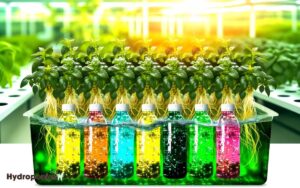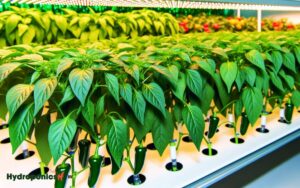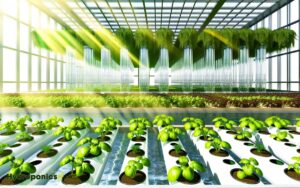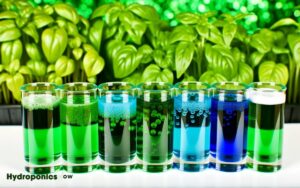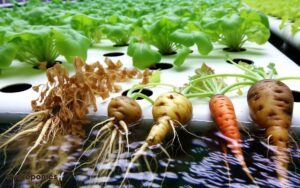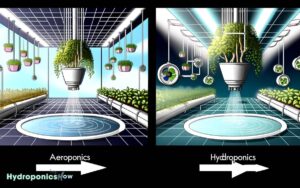Types of Vegetables Grown in Hydroponics: Ideal Choices!
Hydroponics supports the growth of a wide array of vegetables and herbs.
Key leafy greens include lettuce, spinach, and kale, which benefit from rapid growth, efficient nutrient uptake, and disease reduction.
Herbs like basil and mint thrive in controlled hydroponic environments, achieving superior yield and quality. Fruit-bearing plants such as tomatoes, peppers, and strawberries also flourish, each requiring specific nutrient and environmental conditions.
Tomatoes and peppers have precise pH and light requirements, while strawberries demand ideal pH and electrical conductivity parameters.
The tailored hydroponic setup can provide crucial growing conditions for robust plant development.
Explore further to understand the intricate dynamics of hydroponic cultivation.
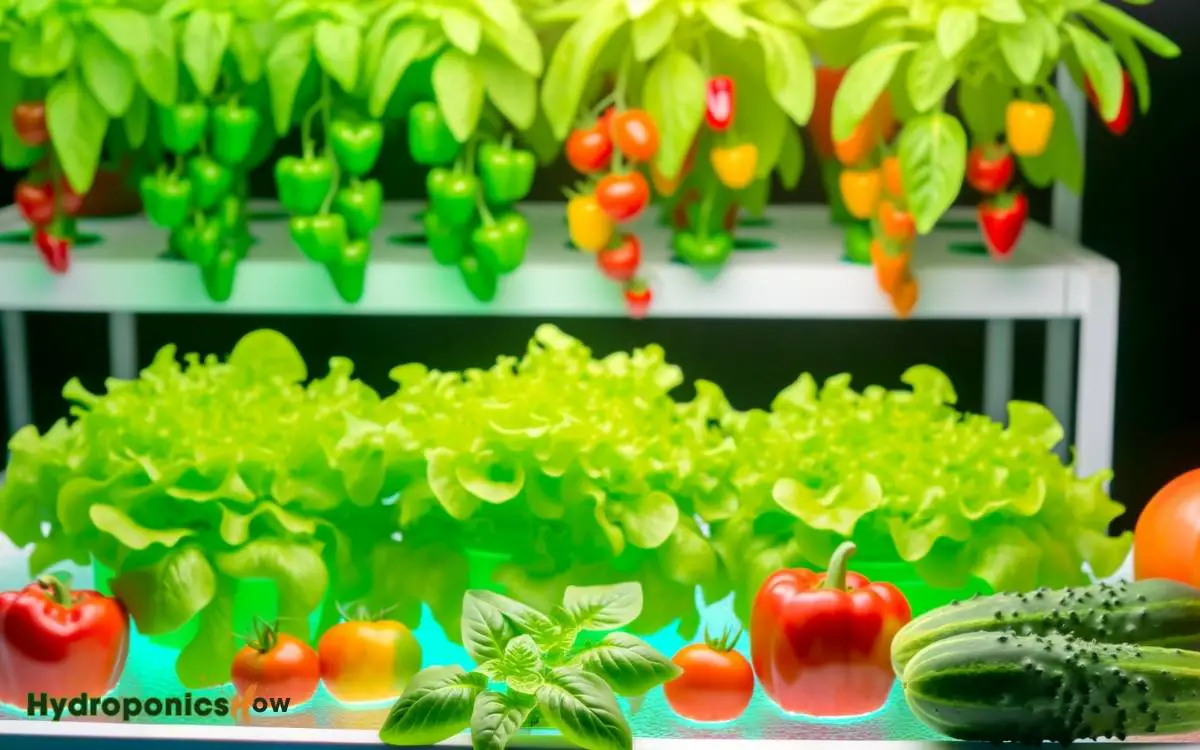
Key Takeaways
Lettuce
Lettuce (Lactuca sativa) is one of the most commonly cultivated crops in hydroponic systems due to its rapid growth cycle, high yield, and minimal nutrient requirements.
This leafy green thrives in a controlled environment where parameters such as pH, electrical conductivity (EC), and dissolved oxygen levels are meticulously regulated.
Hydroponic systems, particularly Nutrient Film Technique (NFT) and Deep Water Culture (DWC), offer ideal conditions for lettuce by ensuring a continuous supply of essential macronutrients like nitrogen, phosphorus, and potassium, as well as micronutrients such as iron and magnesium.
The absence of soil-borne pathogens significantly reduces disease incidence, while the precise control over nutrient delivery enhances both growth rate and nutritional quality, resulting in a consistent and productive harvest.
Spinach
Spinach cultivated hydroponically requires specific growth conditions, including ideal light intensity and temperature regulation, to maximize leaf yield and nutritional quality.
The nutrient solutions must be meticulously balanced, with precise concentrations of essential macro and micronutrients, to support robust growth and prevent deficiencies.
Efficient harvesting techniques, such as continuous cut-and-come-again methods, guarantee sustained productivity and high-quality produce.
Growth Requirements
Ideal hydroponic cultivation of spinach requires precise control of environmental parameters including:
- Nutrient concentration, with spinach thriving in a nutrient-rich solution with an electrical conductivity (EC) between 1.8 and 2.3 mS/cm.
- pH levels, with the best range being 6.0 to 7.0 to ensure maximal nutrient uptake.
- Light intensity, which should be maintained at 14-16 hours per day, with an ideal photosynthetically active radiation (PAR) of 200-400 µmol/m²/s.
- Temperature control, critical for spinach cultivation, with daytime temperatures ideally set between 18°C and 24°C, and nighttime temperatures not dropping below 16°C.
Humidity levels should also be considered and maintained between 50-70% to prevent fungal diseases and ensure vigorous growth. Precise control of these parameters guarantees optimal spinach yield and quality.
Nutrient Solutions
Formulating an effective nutrient solution for hydroponic spinach cultivation involves a meticulous balance of macronutrients and micronutrients tailored to meet the plant’s specific physiological requirements.
Essential macronutrients such as nitrogen (N), phosphorus (P), and potassium (K) are required in specific ratios; typically, an N-P-K ratio of 8-15-36 promotes ideal leaf growth and vigor.
Micronutrients, including iron (Fe), manganese (Mn), zinc (Zn), and boron (B), are equally critical, albeit in trace amounts. Calcium (Ca) and magnesium (Mg) must also be adequately provided to prevent deficiencies that could impair cellular functions and photosynthesis.
pH levels should be maintained between 5.5 and 6.5 to ensure nutrient availability and uptake efficiency. Regular monitoring and adjustments are imperative to sustain the best growth conditions.
Harvesting Techniques
Harvesting spinach in a hydroponic system necessitates precise timing and technique to maximize yield and guarantee the highest quality of the leaves.
Best harvest time occurs when leaves reach 4-6 inches in length, ensuring tenderness and nutrient density.
Utilize sterilized, sharp scissors to minimize tissue damage and reduce pathogen introduction. Cut the outer leaves first, allowing the central rosette to continue growing, promoting continuous production. Employ a staggered harvesting schedule to maintain a consistent supply.
Post-harvest, immediately immerse leaves in cold water to halt enzymatic activity and preserve freshness. Ensure thorough drying before storage to prevent bacterial growth.
Implementing these methods enhances leaf quality, prolongs shelf life, and maximizes the efficiency of hydroponic spinach cultivation.
Kale
Kale, a nutrient-dense leafy green, thrives exceptionally well in hydroponic systems due to its ability to efficiently absorb water and nutrients through its root structures.
This cruciferous vegetable, known for its high concentrations of vitamins A, C, and K, along with essential minerals such as calcium and potassium, benefits from the controlled environment of hydroponics.
Peak growth is achieved through precise regulation of pH levels (5.5-6.5) and electrical conductivity (EC) values, ensuring a balanced nutrient solution. Additionally, hydroponic systems mitigate soil-borne diseases and pests, enhancing plant health and yield.
The rapid growth cycle, typically 4-6 weeks, allows for multiple harvests annually, making kale an ideal candidate for sustainable, high-efficiency production.
Basil
Basil, an aromatic herb frequently utilized in culinary applications, thrives in hydroponic systems due to its efficient nutrient uptake and rapid growth under controlled environmental conditions.
In hydroponics, basil benefits from a consistent supply of essential macronutrients—nitrogen, phosphorus, and potassium as well as micronutrients such as magnesium and calcium, which are critical for chlorophyll synthesis and cell wall integrity.
Ideal growth conditions include maintaining a pH range of 5.5 to 6.5 and providing sufficient light intensity, ideally in the range of 18-24 hours of light per day using full-spectrum LEDs.
The absence of soil pathogens and the ability to meticulously regulate humidity and temperature further enhance basil’s growth, leading to superior yield and quality compared to traditional soil cultivation.
Tomatoes
Tomatoes, a staple in both commercial agriculture and home gardening, exhibit remarkable adaptability to hydroponic cultivation due to their precise nutrient requirements and sensitivity to controlled environmental parameters.
Hydroponically grown tomatoes benefit from optimized conditions, resulting in higher yields and consistent quality.
Key considerations in hydroponic tomato cultivation include:
- Nutrient Solution: A balanced mix of nitrogen, phosphorus, potassium, and trace elements tailored to the plant’s growth stage guarantees robust development.
- Light Management: Utilizing full-spectrum LED lights can simulate sunlight, allowing for year-round production and ideal photosynthesis.
- Temperature and Humidity Control: Maintaining temperatures between 18-25°C and relative humidity around 70% minimizes pest and disease prevalence.
Cucumbers
Cucumbers thrive in hydroponic systems due to their rapid growth cycle and sensitivity to precise nutrient and environmental controls, making them an ideal candidate for high-efficiency agricultural practices.
Hydroponic cucumbers benefit from a meticulously balanced nutrient solution, typically comprising macronutrients like nitrogen, phosphorus, and potassium, alongside essential micronutrients. Essential pH levels between 5.5 and 6.0 are essential for nutrient uptake.
Environmental parameters such as temperature (24-27°C) and relative humidity (60-70%) must be carefully monitored to prevent diseases and promote healthy growth. The use of trellising systems supports vertical growth, maximizes space utilization, and enhances air circulation.
These factors collectively contribute to higher yield, improved fruit quality, and reduced pest and disease incidence compared to traditional soil cultivation.
Peppers
Peppers, encompassing a range of varieties such as bell peppers, chili peppers, and sweet peppers, thrive in hydroponic systems due to their ideal environment.
Ideal growing conditions for hydroponic peppers include maintaining a nutrient solution with a pH range of 5.5 to 6.5, ensuring sufficient light intensity, and providing consistent temperature regulation between 70-80°F (21-27°C).
Nutrient requirements are critical, with peppers necessitating a balanced supply of macronutrients nitrogen, phosphorus, potassium and micronutrients for robust growth and fruit development.
Varieties of Hydroponic Peppers
A diverse array of pepper varieties, including bell peppers, jalapeños, and habaneros, can be successfully cultivated using hydroponic systems, which offer precise control over nutrient delivery and environmental conditions.
This method enhances growth efficiency and yield quality through the following mechanisms:
- Nutrient Solution Formulation: Tailored nutrient solutions guarantee optimal availability of essential macronutrients and micronutrients, essential for robust pepper development.
- pH Regulation: Maintaining an ideal pH range (5.5-6.5) facilitates nutrient uptake and prevents deficiencies, vital for the physiological processes of peppers.
- Environmental Control: Regulated temperature, humidity, and light intensity promote consistent growth cycles and reduce stress factors, leading to higher fruit quality and uniformity.
Optimal Growing Conditions
To achieve essential growth conditions for hydroponic peppers, it is crucial to meticulously manage variables such as nutrient concentration, light spectrum, and photoperiod to maximize physiological and developmental processes.
Ideal temperature ranges between 70-80°F (21-27°C) during the day and 60-70°F (16-21°C) at night. Relative humidity should be maintained at 60-70% to prevent both desiccation and fungal pathogens.
The light spectrum should include both red and blue wavelengths, with a photoperiod of 14-16 hours of light per day to promote robust vegetative growth and flowering.
Additionally, maintaining a pH range of 5.8-6.3 in the nutrient solution is crucial for optimal nutrient uptake and overall plant health, ensuring vigorous pepper production.
Nutrient Requirements for Peppers
Ensuring efficient nutrient uptake in hydroponic pepper cultivation necessitates a carefully balanced nutrient solution, rich in essential macronutrients such as nitrogen, phosphorus, and potassium, as well as trace micronutrients like calcium, magnesium, and iron.
Proper nutrient management is important for best growth, fruit development, and overall plant health.
Specifically, peppers require:
- Nitrogen (N): Important for vegetative growth and leaf development. Insufficient nitrogen can stunt growth and reduce yield.
- Phosphorus (P): Essential for root development and energy transfer. Deficiency leads to poor root systems and delayed flowering.
- Potassium (K): Crucial for fruit quality and disease resistance. Lack of potassium can result in weak stems and poor fruit formation.
Balanced nutrient ratios and regular monitoring ensure robust pepper growth in hydroponic systems.
Strawberries
Growing strawberries with hydroponic systems provides significant advantages through controlled environment agriculture, nutrient management, and optimized plant growth conditions.
This method allows for precise regulation of light, temperature, humidity, and nutrient delivery, thereby enhancing fruit yield and quality.
Hydroponic systems, such as nutrient film technique (NFT) and deep water culture (DWC), enable efficient use of water and fertilizers, reducing waste and environmental impact.
The following table outlines key parameters for hydroponic strawberry cultivation:
| Parameter | Ideal Range |
|---|---|
| pH Level | 5.5 – 6.5 |
| EC (mS/cm) | 1.4 – 2.0 |
| Light Intensity | 14-16 hours/day |
| Temperature | 18-24°C (64-75°F) |
These controlled conditions facilitate faster growth cycles, consistent fruiting, and reduced pest incidence, making hydroponic strawberries a sustainable and profitable choice for modern agriculture.
Mint
Mint, a perennial herb, thrives in hydroponic systems due to its minimal growth requirements and adaptability to controlled environments.
Ideal nutrient solutions must include a balanced mix of nitrogen, phosphorus, and potassium to guarantee robust growth and vibrant foliage.
Efficient harvesting techniques involve regular trimming to promote continuous growth and prevent over-crowding.
Growth Requirements
Ideal hydroponic cultivation of mint requires precise control over environmental parameters such as nutrient concentration, pH levels, and light exposure. Maintaining peak conditions guarantees vigorous growth and high-quality yield.
Key growth requirements for mint in hydroponics include:
- pH Range: Mint thrives in a pH range of 5.5 to 6.5, which maximizes nutrient uptake and prevents nutrient lockout.
- Light Exposure: Mint requires 14-16 hours of light per day, ideally from full-spectrum LED grow lights, to support photosynthesis and robust growth.
- Temperature: The ideal temperature range for mint is between 18°C to 24°C (64°F to 75°F), facilitating efficient metabolic processes and minimizing stress.
Nutrient Needs
To guarantee maximum growth and high-quality yield, mint in hydroponic systems requires a balanced nutrient solution rich in essential macro and micronutrients.
Macronutrients such as nitrogen (N), phosphorus (P), and potassium (K) play pivotal roles in vegetative growth, root development, and overall plant health.
Additionally, calcium (Ca), magnesium (Mg), and sulfur (S) are vital for cell wall stability, photosynthesis, and amino acid synthesis.
Micronutrients, including iron (Fe), manganese (Mn), zinc (Zn), copper (Cu), molybdenum (Mo), and boron (B), are imperative in trace amounts for enzymatic functions and metabolic processes.
Hydroponic nutrient solutions should maintain electrical conductivity (EC) between 1.4-2.0 mS/cm and a pH range of 5.5-6.5 to optimize nutrient uptake and foster robust mint growth.
Harvesting Tips
For best harvest quality, make sure that mint is harvested just before the flowering stage when the essential oil concentration is at its peak. This guarantees maximum potency and flavor.
Adhere to the following steps for best results:
- Time of Day: Harvest mint in the early morning when the essential oil levels are highest.
- Cutting Technique: Use sterilized shears to cut stems about 1-2 inches above the node to encourage regrowth.
- Post-Harvest Handling: Immediately place the cut mint in water to prevent wilting and degradation of essential oils.
Arugula
Arugula (Eruca vesicaria subsp. sativa) is a nutrient-dense leafy green that thrives in hydroponic systems due to its rapid growth cycle and minimal nutrient requirements.
It flourishes in controlled environments with ideal pH levels ranging from 6.0 to 7.0 and an electrical conductivity (EC) of 1.0 to 1.5 mS/cm.
Hydroponic arugula benefits from a nutrient solution rich in nitrogen, phosphorous, and potassium, essential for foliage development.
This crop achieves maturity within 30 to 40 days, making it an efficient choice for continuous harvesting.
The use of deep water culture (DWC) or nutrient film technique (NFT) systems further enhances arugula’s growth, providing consistent access to oxygenated nutrient solutions, thereby promoting robust root development and vigorous leaf production.
Conclusion
Hydroponic cultivation has demonstrated significant potential for growing a wide array of vegetables, including lettuce, spinach, kale, basil, tomatoes, peppers, strawberries, mint, and arugula. This innovative method allows farmers to grow crops efficiently without traditional soil, using nutrient-rich water solutions instead. While hydroponic systems eliminate the need for soil, growers often use alternative growing mediums like coconut coir, perlite, or rock wool, which can serve as the best soil for hydroponic vegetables by providing stability and optimal root support. As a result, hydroponic farming can produce higher yields in smaller spaces while conserving water and reducing the risk of soil-borne diseases.
For instance, a controlled study at the University of Arizona’s Controlled Environment Agriculture Center revealed that hydroponically grown lettuce exhibited a 25% faster growth rate compared to soil-grown counterparts.
This method offers enhanced control over nutrient delivery, water usage efficiency, and space utilization, making it a viable solution for sustainable agriculture in urban environments.

